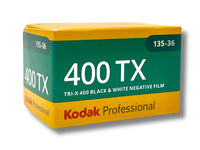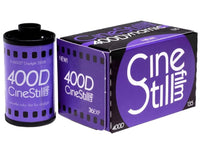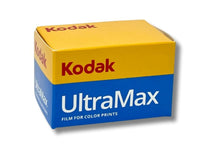Black Friday 2025 has landed at Analogue Wonderland, bringing some of our biggest film photography deals of the year - from discounted film and cameras to money-saving WonderLab processing offers, exclusive bundles, and festive specials available for a limited time only. Grab a great deal while stocks last!
Recent posts
Shop the article

Film: the balance between patience and perfectionism
One of the things that a love about film is that it helps me slow down and focus on the moment. Having a limited number of shots me to take my time and really think about whether I’m taking the shot that I want. I think that the magic of the wait and the capturing of a very particular moment in time, never to be repeated, is one of the reasons a lot of us shoot film.
With digital photography when you see something interesting you can just start shooting and keep shooting as you move around, review the photos you’ve taken, and explore it further, until you find the shot you like the best. Other than time spent sorting through your photos later, there’s no cost to taking as many photos as you like. This can be a big benefit – especially when shooting portraits or candids, because it’s much easier to get a shot whether your subjects all have their eyes open or a good facial expression when you have a lot of options!

Shot on Kodak Tri-X 35mm film - Paris 🇫🇷
Not so with film photography – when you are paying around £1 per photograph for film and development, all of this exploring to find the perfect shot needs to happen inside your head, visualised before you pull the trigger. Being forced to take the time to do this process has really helped me learn to look for composition and be aware of what is going on around me when I’m getting ready to take the photo – is this the best angle? Is someone about to walk in front of my camera? Is the sun about to go behind a cloud?
Add to that the need to keep track of shutter speed, aperture, and manually focusing on your subject, and the pressure of trying to get everything right the first time, and film photography can become a high-stakes, learn-by-doing crash course in how to become a better photographer!
This sense of capturing one moment that will never be replicated is something that makes film photography incredibly special. Unlike digital, it has that feeling of timelessness and authenticity. But the pressure of a limited roll of film can also be a challenge, especially for those of us who have a tendency towards perfectionism. What do you do when you take the shot and you realise that it was not the shot you wanted?

Halation in Paris - this time on Cinestill 400D
In the year and a half that I have been shooting film, I’ve been trying to learn how to balance this urge to conserve my film, waiting for the perfect shot, with each little fleeting opportunity to capture a moment. There have been photos I regret taking where I “wasted” a shot that I would have rather used later and photos that will only live in my memory because I wasn’t fast or decisive enough to capture them.
I think the main way to work your way to this balance – tough as it is – is through trial and error. But here a couple of the things I consider to help myself continually strive for it.
If I take a shot and I’m not happy with how I think it will turn out, is it worth it to try again?
This might be a composition error (someone got in the way of your shot, you didn’t notice people in the background, or you’ve just discovered a better angle) or a technical one (the times I’ve cursed myself for forgetting to change my shutter speed in different lighting conditions), but whatever the problem, it helps to ask yourself how important that shot is to you. If it’s a photograph that you are particularly excited about, one that might haunt you if you don’t manage to capture it how you envisaged it, then it might be worth the extra attempt. There have been times when I’ve been really glad I took the extra photo, because it turned out so much better than the first one and I was really happy with it. My personal rule though is that I don’t get more than two tries – one missed shot might be a mistake, but if I mess up two in a row then it’s time to cut my losses and learn the lesson for next time!
I took these two shots on Kodak Ultramax 400 on a day in London – the woman sitting on the bench in her bright red coat caught my eye, but I was too rushed trying to take the first photograph unobtrusively – I didn’t go close enough and I didn’t notice the people in the background who had walked into the frame.

I realised when I’d taken it that it wasn’t what I wanted, and I thought that it would make a really good photo, so I waited for the people to walk out of frame and then tried again, and I was really happy with the final result!

Why am I shooting this roll?
There are some times when you have the option for patience – if you’re taking a landscape, a detail, or an architectural shot, your subject is probably not moving too much.
On the other hand, if you’re shooting street photography or candids or a sporting event, you have to act fast to respond to the moments that appear. In these cases, I try to give myself a bit more permission to take the chance. I know that I’ll probably have a higher percentage of shots that don’t turn out how I was hoping, but by taking these chances, I’ll hopefully get a couple that capture the perfect moment, that I wouldn’t have managed to take if I was second-guessing every shot I thought about taking.

That’s the idea anyway – I just sent a roll of film to Analogue Wonderland for development that I took at the Oxford Summer VIIIs rowing competition, and I’m hoping some of them turn out... Spoiler alert: check out the article header. They did!
This balance is a work in progress, but I think that it’s one of the best things that I’m learning from film for life – how to tell when to think it through to get the best outcome and when to take a chance to grab an opportunity!
Written by:
Madison Milne-Ives. Maddie is a relative newcomer to film photography. She started shooting film at the end of 2022, when she got her hands on her mom’s old film camera (a Minolta X-700) when they moved house. You can follow her on Instagram at @m.m.i_photography
Ready to dive in?
Keep Reading
View all
Christmas 2025: Shipping & Opening Hours
Christmas 2025 is fast approaching! To make sure your analogue goodies arrive in time, take note of our last shipping dates, plus opening and operating hours over the festive season. We've got everything you need to gift the magic of film photography this Christmas!

Film Photography Christmas Gift Guide 2025: Analogue Wonderland
Capture the magic of Christmas with film - no filters needed. Our 2025 Film Photography Christmas Gift Guide 2025 is packed with thoughtful presents for every type of shooter, from curious beginners to seasoned photographers. Discover film stocks, cameras, and creative accessories that will make this festive season truly memorable.
Subscribe to our newsletter 💌
Sign up for our newsletter to stay up to date on film photography news, sales and events:
Free Tracked Shipping
On all UK orders over £50
Passion For Film
An unbeatable range and an on-site lab
Our Customers Trust Us
Thousands of independent 5* reviews
All Deliveries are Carbon Neutral
Independently audited and verified by Planet
- Opens in a new window.








3 Comments -
doug • -
Ashley • -
bill sherren •
I don’t limit myself on a shot necessarily. I will always try to compose and capture the first time around but if it’s an image I really want, then devoting multiple frames to it may be beneficial. I’ll also bracket if the lighting requires it to assist in capturing the moment sought.
This was really interesting, thanks so much for sharing. I like the thought of limiting to two attempts. I can be a little obsessive at times and be left with 3 or 4 of the same shot! 😅 Will try this next on my next roll 😊
Of course one of the challenges with shooting with film is not finding out something was not quite right till days, weeks or even months later! But it’s these unexpected results which can make analog photography so rewarding.